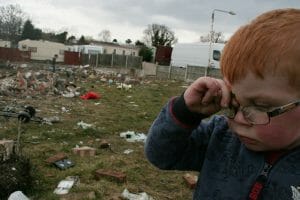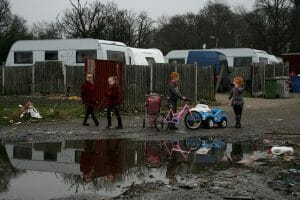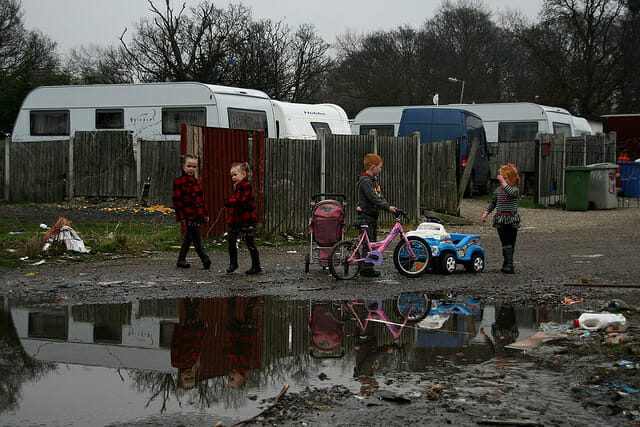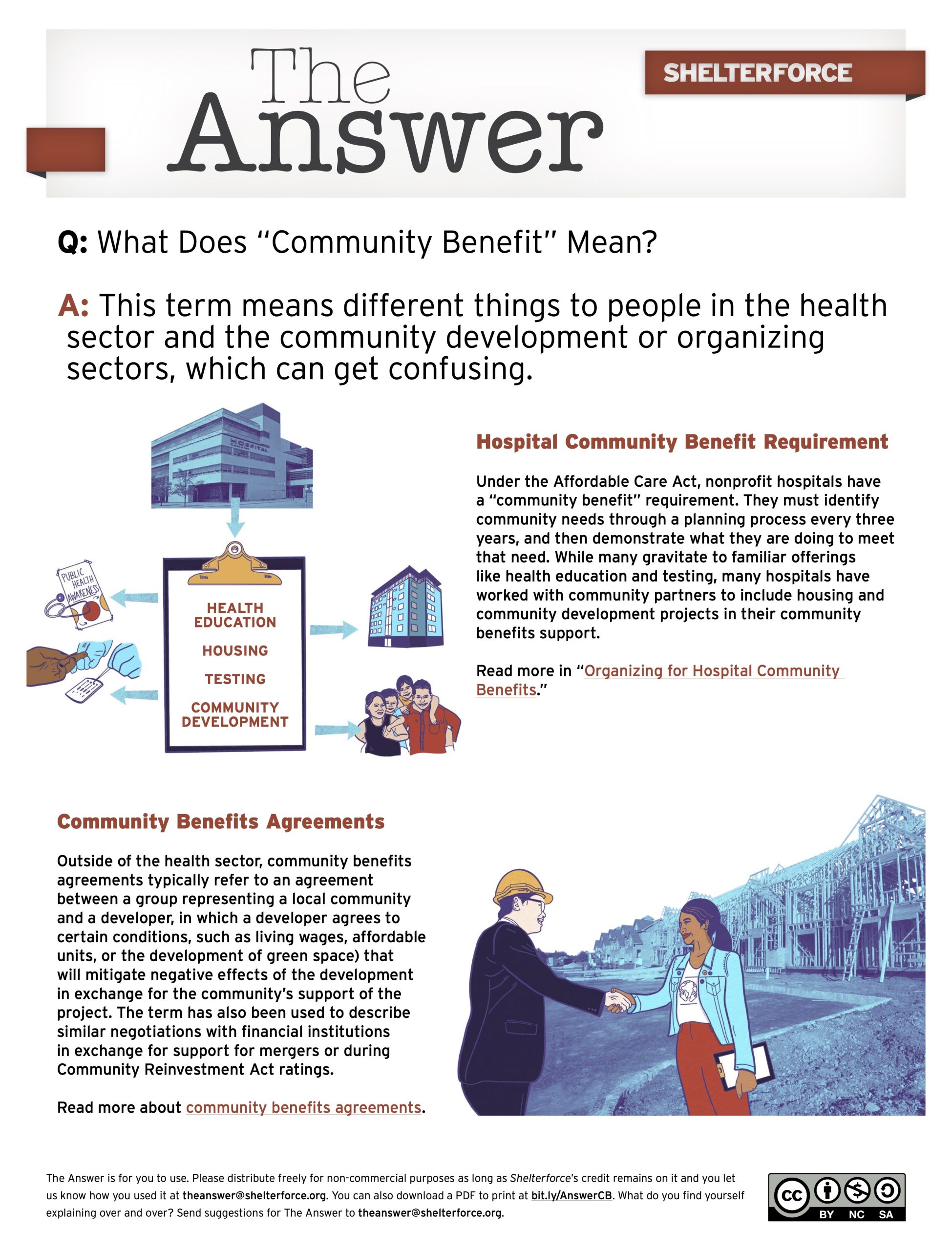
A young boy named Richard plays in Dale Farm in 2010, which according to The Guardian was once the site of the largest concentration of Irish Travellers until families were evicted in 2011. Photo by Susan Craig-Greene via flickr user The Advocacy Project, CC BY-NC-ND 2.0
Irish Travellers are an ethnic minority group in Ireland who have a distinct culture, lifestyle, and language. When Ireland was an agrarian rural economy, Travellers played an economic and cultural role in Irish communities, developing relationships with farmers and townspeople by horse trading and selling and repairing tin and metal. They moved from villages and towns in barrel-topped caravans, with some families traveling locally and others making the journey around the country and to the United Kingdom. Families travelled in groups and often returned to the same “halting site” or campsite year after year, with women and children relying on local farmhouses for food and clothing donations as they camped.
The lifestyle of Irish Travellers has changed along with the urbanization of Ireland, and the country has not yet figured out how to adequately provide for their housing, education, and health care in a culturally appropriate way. Travellers currently suffer from comparatively worse health than other populations in Ireland, and they rely more heavily on the government than most to meet their housing needs.
While managing an urban community development and housing revitalization program in Tralee, a town in southwestern Ireland, I had the opportunity to oversee the community, voluntary, and public-sector policies and programs aimed at increasing social and economic opportunity within the Traveller population there. We conducted a Health Impact Assessment (HIA) in a number of Traveller-specific housing projects. These HIAs succeeded where many other consultative structures and groups had failed because they empowered Travellers where there was previously only conflict, mistrust, and anger.
Travellers, like other nomadic minorities, have accommodation desires and demands that have never been incorporated successfully into broader social housing policy, even though the majority of Traveller families rely on local housing authorities to meet their housing needs. The Irish government has historically wanted to settle Irish Travellers into existing social housing options with the intention of solving the “itinerant problem” by assimilating them into the majority of Irish society.
Irish Traveller Demographics
Compared to the majority population, Irish Travellers have more children, larger extended families, and more complex social and economic arrangements based on family groupings. Many families “hit the road” during the summer months to attend horse fairs around the country and visit family, and travel is typically undertaken in small caravans; when they stop they squeeze onto the side of a road, in a public green, or in a privately owned field.
Only 12.8 percent of Travellers surveyed in 2008 owned the home where they resided, compared to 70.3 percent of a comparable cohort of the Irish population. Almost 95 percent of Travellers had a current medical card, which provides access to free health care for low-income adults and children, and only 4.8 percent of respondents reported employment or self-employment.

An Irish Traveller site on Dale Farm in 2011. Photo by Susan Craig-Greene via flickr user The Advocacy Project, CC BY-NC-ND 2.0
The majority of Irish communities and lawmakers believe that Travellers—who represent less than 1 percent of the population in Ireland—should change their way of life. Certainly, nomadism has implications for any community’s ability to participate in and access standard economic, education, and health systems. Traveller advocates and representatives, however, lay responsibility for the continued poor outcomes on ethnic discrimination and government choices, such as promoting a one-size-fits-all social housing model. Poor quality and culturally inappropriate housing affects Travellers’ physical and mental health negatively.
In 2007, the Republic of Ireland and Northern Ireland jointly funded the first study of Traveller health based on previous recommendations from the Department of Health and Children. Its results showed stark difference between Traveller health and mortality in comparison to the Irish population as a whole, as well as to other segments of the population with similar economic status.
The Traveller population was estimated at around 36,224, with 42 percent of the study’s participants under the age of 15. Only 3 percent of Travellers were 65 years old, compared with 13 percent of their peers. The Traveller infant mortality rate was 14.1 in 2008 compared to 3.9 for Ireland. The life expectancy gap between Traveller women and settled women was 12 years in 2008; 15 years for Traveller men (up from 10 years in 1987). The suicide rate is six times higher than the rate of the general population. The study also found that Travellers experience high levels of isolation from the wider community, discrimination, and sense of powerlessness around their living conditions and future prospects.
Housing
The vast majority of Travellers live in standard-issue housing despite there being a legal requirement that the government provide Traveller-specific accommodation. This type of accommodation includes permanent halting sites with serviced bays for tenants to park their own mobile homes, or the ability to rent mobile homes or caravans on the site. These halting sites vary in size and the facilities vary greatly depending on the city or town. Often the service bays are merely dirt lots with rat infestation, lack of drainage or sewage facilities, and no hot water.
Halting sites are usually located on the outskirts of towns and cities, near highways or refuse areas, and behind tall walls. There is often no pedestrian access to facilities or services in the wider community. The local housing authorities also provide prefabricated buildings on halting sites, which are often combined with caravans when demand for sites surpasses supply. In 2015, a fire killed people who were living on a halting site in Carrickmines, a suburb of Dublin. The site was meant to be temporary, but families had been living there for eight years. The site had a combination of prefabricated units and caravans, there was no fire hydrant, and the overcrowding contributed to the rapid spread of the fire.
Unofficial halting sites are used both by the community and by the housing authorities to temporarily house Travellers who do not want to live in non-Traveller-specific housing options when official halting sites are not available. Unofficial sites have no infrastructure or facilities and are on roadsides, in parking lots, or unused strips of wasteland. Though they are supposed to be temporary measures, families often stay there for years.
Using a Health Impact Assessment to Improve Conditions
The failures of Ireland’s Traveller accommodation program made clear to me the link between empowerment in housing service provision and the ability to develop a sustainable community.
Using a Health Impact Assessment in the redesign of existing Traveller accommodation created an empowering interagency process and the potential for a better outcome.
When I led the urban revitalization program in Tralee between 2007 and 2013, one of the goals was to redesign a housing site that had turned into segregated Traveller housing with serious community safety concerns for the residents and the town. There was no common ground or mutual understanding between Travellers and the local authority. The county’s housing authority struggled to divide a limited pool of resources between Travellers’ unique accommodation needs and the housing needs of the larger community. Local social service providers generally viewed Travellers as a burden on resources, and Travellers viewed service providers and lawmakers with distrust and anger.
Local Traveller Consultative Committees are supposed to be the tools through which Travellers and local authorities plan, design, and monitor county-specific Traveller Accommodation programs, but the experience of the members in this county were not positive and the group achieved few results.
My observations were mirrored on a national level by The Irish Traveller Movement (ITM), which participates in the national consultative body on Traveller housing. The body points to the consistent failure of local authorities to meet targets for culturally appropriate accommodation options, such as halting sites, group housing schemes, and transient sites, and the continued poor conditions of existing Traveller-specific halting sites. Since 2013 the ITM has defined the Traveller accommodation issue as a crisis due to budgets cuts and a growing unmet need for housing; 3,600 Traveller families were defined as officially homeless in 2013 by the ITM.
There was one glimmer of hope—the use of a Health Impact Assessment, or HIA, in the redesign of a halting site in Killarney, another town in County Kerry. The Deerpark halting site was (and remains) located between two sections of a national road that runs from Cork to Killarney to Tralee. The site is entered and exited via a dirt road from the main road with no signs, markers, or pedestrian cross walks, and town facilities and commercial areas are only accessible by driving on the national road or crossing over it.
The site had old prefabricated chalets, poor sanitation, insufficient lighting, poor landscaping, and a history of difficult relations amongst resident families over the years. The existing chalets were cramped and there were no areas for children or the community. The management and maintenance of the site was a long-running source of complaint for residents. Like many other halting sites, the entrance contained a barrier to prevent Travellers with mobile homes from moving into the site without making arrangements for rental. These barriers also could prevent ambulances and fire engines from accessing the site without keys. Residents reported high levels of stress and depression around the lack of space, amenities, and stability in their own homes.
The Kerry Local Traveller Consultative Committee had agreed to renovate the halting site and committed to apply the Health Impact Assessment tool in designing the redevelopment. The Department of Health funded and hired an independent Health Impact Assessment practitioner to facilitate the process. The objectives were to ensure the positive health impacts of the site were enhanced and negative impacts reduced, promote Traveller participation in the redevelopment decision-making process, and develop a shared understanding of the links between the design of the site and the health of the residents.
The HIA is a methodology defined by the European Center for Health Policy as “a combination of procedures, methods, and tools by which a policy, program, or project may be judged as to its potential effects on the health of a population, and the distribution of those effects within the population.” The most important element of the HIA process in Killarney was that it was undertaken with the residents as equal partners. Kerry Travellers Community Development Project supported the residents.
The Health Impact Assessment group consisted of representatives from the housing authority, the health service, the police, the community development project, and residents. The site houses eight families, whose participation fluctuated, but all residents were able to participate in different ways. The assessment included structural factors at the site, as well as individual and family behavioral factors.
HIAs involve five stages: screening, scoping, appraisal, developing recommendations, and monitoring and evaluation. The group made 70 recommendations, classified under social determinants of health, and then formed an implementation group to prioritize them and assist the housing authority with their implementation. The Health Impact Assesesment resulted in the refurbishment and extension of eight chalets, a new community center and playground, and improved lighting and landscaping. Residents chose to rename the site St. Michael’s, which was celebrated with a community mass at a newly created grotto with a statute of the Virgin Mary. The Kerry County Council and the Kerry Travellers Development Project were positive about the process and outcomes. Most importantly the residents were empowered in decisions around their own homes.
The lessons learned in this process were applied to a much larger and more public Traveller group housing scheme built to replace standard social housing in Tralee. HIAs have also been used in Galway, Cork, and Dublin at specific halting sites and in Dongeal in the overall Traveller accommodation plan for the county.
Galway Traveller Movement produced a toolkit for others to use when assessing conditions on Traveller sites using the HIA process. The lessons learned about specific projects can be applied to the larger policy issue of Traveller and culturally appropriate housing.
The development of a shared understanding of the health impacts of programs, projects, and services can only be developed with the empowerment of residents. The empowerment of public housing residents requires the delegation of power from the housing authority. This is a challenge for housing authorities. They bear the responsibility for fiscal management, project management, and insurance and are accountable to constituents as a whole. It is critical for the residents to understand these constraints from the start of any planning process so they can make an informed decision about the costs benefits of participation.
The screening phase of the Health Impact Assessment can be applied to any project or policy to determine the terms of reference before communities and service providers begin a consultation process. As in other community participation processes, residents might require training, administrative support, expense reimbursement, and other community development supports to participate in an interagency decision-making process with paid professionals. The communication skills, mutual understanding, and trust developed through a process like the HIA should be applied to the implementation of the recommendations and the ongoing management of the housing service or site.
The reframing that emerged from these processes resulted in the formation of a Traveller-led housing association, called Cena, in 2015. The Irish Traveller Movement, with the support of the government, formed Cena—the word for home in Cant, a language spoken by Travellers—with the mission to “lead the way in innovation and best practice in the design, delivery, and management of culturally appropriate accommodation to Travellers, and build strategic relationships with other social housing provider to achieve its vision.”
Cena partnered with two local authorities to deliver eight units of culturally appropriate accommodation, which will hopefully be a model for the empowerment of this population in Ireland. The process has been slow and challenging, and indeed one local authority is at risk of losing the pilot funding because of the failure of local councilors to allocate an appropriate site. The second project has progressed through planning and construction stages.
Unfortunately, looking more broadly, only 7 of the 31 local government councils drew down any allocated funding by the Department of Housing for Traveller-specific accommodation in 2017 and over half of allocated budgets went unspent. This failure to act highlights the crisis in Traveller housing that will only be remedied when local communities and elected representatives commit to new ways of working with minority communities.






Comments